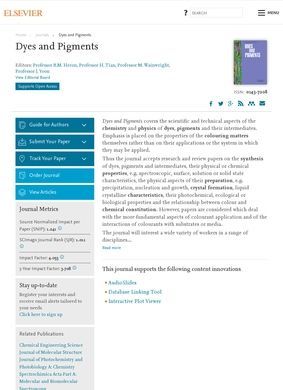Dyes and Pigments is a scientific journal published on ScienceDirect.com by Elsevier. The journal facilitates open access and maintains a significant Impact Factor of 4.5, as well as a CiteScore of 8.3. It acts as a platform for publishing and providing access to a wide range of content such as latest issues, articles in press, special issues and article collections, linked datasets, and guides for authors. It also features an efficient order journal functionality.
The content in Dyes and Pigments extensively covers the scientific and technical aspects of the chemistry and physics of dyes, pigments, and their intermediates. Putting emphasis on the properties of the colouring matters themselves, the journal primarily focuses on their analysis rather than their applications or the system in which they may be applied.
The journal welcomes comprehensive research and review papers on the synthesis of dyes, pigments, and intermediates. It considers studies on their physical or chemical properties, such as spectroscopic, surface, solution, or solid-state characteristics. Additionally, it examines the physical aspects of their preparation, including precipitation, nucleation and growth, crystal formation, and liquid crystalline characteristics.
Dyes and Pigments also encourages papers investigating their photochemical, ecological or biological properties, as well as the relationship between colour and chemical constitution. While the main focus is on the properties of the dyes and pigments themselves, the journal also considers papers that delve into the more fundamental aspects of colourant application and the interactions of colourants with substrates or media.
Overall, this journal would be held in high regard by a wide variety of workers in the scientific community due to its focus on providing detailed insights into the chemistry and physics of dyes and pigments. Its recognition of diverse research, in-depth examination of dye and pigment properties, and openness to complex discussions about interactions and applications ensure a broad scope of content that caters to a scholarly audience.
